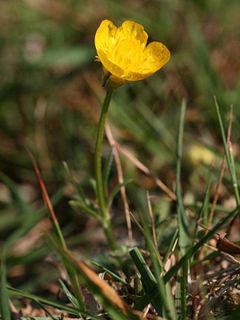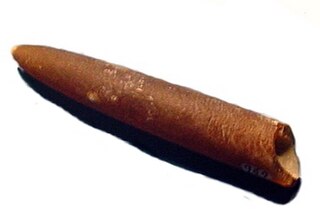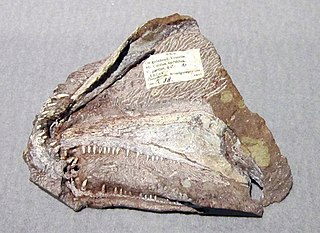
Calypso is a genus of orchids containing one species, Calypso bulbosa, known as the calypso orchid, fairy slipper or Venus's slipper. It is a perennial member of the orchid family found in undisturbed northern and montane forests. It has a small pink, purple, pinkish-purple, or red flower accented with a white lip, darker purple spottings, and yellow beard. The genus Calypso takes its name from the Greek signifying concealment, as they tend to favor sheltered areas on conifer forest floors. The specific epithet, bulbosa, refers to the bulb-like corms.

Nicolette Larson was an American pop singer. She is perhaps best known for her work in the late 1970s with Neil Young and her 1978 hit single of Young's "Lotta Love", which hit No. 1 on the Hot Adult Contemporary Tracks chart and No. 8 on the pop singles chart. It was followed by four more adult contemporary hits, two of which were also minor pop hits.

Arethusa bulbosa, commonly called dragon's mouth orchid, is the only species in the orchid genus Arethusa. The genus is named after a naiad of Greek mythology. This monotypic genus is abbreviated Aret in trade journals.

The side-striped jackal is a canine native to central and southern Africa. Unlike the smaller and related black-backed jackal, which dwells in open plains, the side-striped jackal primarily dwells in woodland and scrub areas.

Ranunculus bulbosus, commonly known as bulbous buttercup or St. Anthony's turnip, is a perennial flowering plant in the buttercup family Ranunculaceae. It has bright yellow flowers, and deeply divided, three-lobed long-petioled basal leaves.

Bulbine bulbosa, commonly known as bulbine lily, is a flowering plant in the genus Bulbine. It is endemic to Australia.

Erigenia bulbosa, also known as harbinger of spring or pepper and salt, is a perennial plant in the family Apiaceae. E. bulbosa is the only species in the genus Erigenia and tribe Erigenieae. This plant is known as harbinger of spring because it is one of the earliest blooming native wildflowers of rich forests in the mid-latitude United States. Throughout most of its range it blooms from late February through early April.
Largirostrornis is a genus of enantiornithean bird. One species has been named, Largirostornis sexdentoris. It lived during the Early Cretaceous and is known from fossils found in the Jiufotang Formation in Liaoning province, People's Republic of China. Some researchers believe this species to be a junior synonym of the similar Cathayornis yandica.

Baculitidae is a family of extinct ammonoid cephalopods that lived mostly during the Late Cretaceous, and often included in the suborder Ancyloceratina.

Parapuzosia is an extinct genus of desmoceratid ammonites from the Cenomanian to the Campanian of Africa, Europe, and North America. They are typically very large ammonites, reaching diameters of 60 cm (2.0 ft) or more, with the largest species measuring upwards of more than 2.5 m (8.2 ft). It possesses a moderately involute shell with flat or slightly rounded sides. Distinct primary and secondary ribbing can be observed in the inner whorls.

Qianosuchus is an extinct genus of aquatic poposauroid archosaur from the middle Triassic (Anisian) Guanling Formation of Pan County, China. It is represented by two nearly complete skeletons and a crushed skull preserved in the limestone. Qianosuchus was at least 3 metres long, and had several skeletal adaptations which indicate a semi-marine lifestyle, similar to modern-day saltwater crocodiles. These adaptations have not been seen in any other archosaur from the Triassic.

Belemnitella is a genus of belemnite from the Late Cretaceous of Europe and North America. Belemnitella was a squidlike animal, probably related to the ancestors of modern squids and cuttlefish. The shell was internal. The rostrum or guard is found the most often and possesses a distinctive slit at its ventral surface and a ridge on the dorsal surface. The phragmocone has a small protoconch at its tip, and fit into the cavity and the guard. It also had septa and a ventral siphuncle within the phragmocone, projecting forward as a beak-like blade.
Peirosaurus is an extinct genus of peirosaurid crocodylomorph known from the Late Cretaceous period of Minas Gerais, southern Brazil. It contains a single species, Peirosaurus torminni. It is the type genus of the family Peirosauridae.

Ymeria is an extinct genus of early stem tetrapod from the Devonian of Greenland. Of the two other genera of stem tetrapods from Greenland, Acanthostega and Ichthyostega, Ymeria is most closely related to Ichthyostega, though the single known specimen is smaller, the skull about 10 cm in length. A single interclavicle resembles that of Ichthyostega, an indication Ymeria may have resembled this genus in the post-cranial skeleton.

Parapuzosia bradyi is a gigantic species of ammonite, reaching diameters of more than 4.5 ft (1.4 m) by 6 ft (1.8 m). It is the largest species of ammonite in North America. It had a moderately involute shell with flat sides. The inner whorls are slightly oval-shaped with prominent ribbing. They are only known from the upper layers of the Eagle Sandstone and Cody Shale formations.

Eutrephoceras is an extinct genus of nautilus from the Late Jurassic to the Miocene. They are characterized by a highly rounded involute shell with slightly sinuous suture patterns.

Squalodontidae or the shark-toothed dolphins is an extinct family of large toothed whales who had long narrow jaws. Squalodontids are known from all continents except Antarctica, from the Oligocene to the Neogene, but they had a maximal diversity and global distribution during the Late Oligocene and Early to Middle Miocene.
Carolinites is a genus of trilobite, assigned to the Telephinidae family, that occurs during the Lower and Middle Ordovician. Carolinites had a pantropical distribution, and there is evidence that it lived in upper parts of the water column. The free cheeks of Carolinites are largely covered by its huge eyes, except for the attachment of large genal spines that extend downward, backward and lateral and gradually curving further backward. The glabella is slightly bulbous, the occipital ring is well defined, but further transglabellar furrows are lacking. The thorax has 10 segments. The axis of the pygidium is highly vaulted, with a curved spine emerging almost perpendicular to the midline and ending parallel to it and a node on each of the other three segments. Carolinites is known from what are today Australia (Tasmania), Canada (Alberta), China, France, Spitsbergen, and the United States (Utah).

Spiclypeus is an extinct genus of chasmosaurine ceratopsian dinosaur known from the Late Cretaceous Judith River Formation of Montana, United States.















